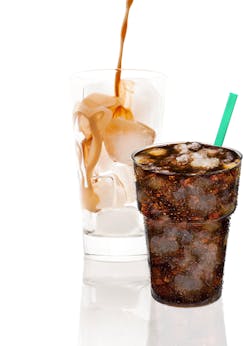Bring Them Back For More... With Ice
Ice is a profitable amenity. It can be added to office coffee service (OCS), pantry service, micro markets and breakrooms with existing vending machines. It is profitable for convenience service providers to incorporate ice machines because they encourage repeat visits to the breakroom. Repeat visits mean more beverage sales. Ice will keep consumers coming back for more.
Profitability of Ice
Ice machines were first popular in OCS, but have gained traction in other convenience services, including micro markets, explained Mike Purcell, product marketing manager, Follett Ice. What helped drive this was the interest of consumers. Having ice machines in breakrooms has been critical to operators offering bag in a box programs for iced coffee and iced tea. “Research shows that people go through more consumables, especially sodas, iced coffee and iced tea, if an ice machine is available,” said Purcell.
There’s profit in leasing ice machines, claims Purcell. After the operator recoups their initial costs from the leasing fee, they continue to collect the leasing fee while performing minimal work because servicing an ice machine is mainly preventative maintenance. Ice machines should be cleaned every six months and the water filters need to be changed regularly. The service can either be separated out from the contract or built into the lease price, but either way the operator should get paid for this service.
Ice has become popular in micro markets because it’s like a “completer,” explained Purcell. Not only does it encourage cold beverage sales, but it helps keep the market competitive. “A micro market doesn’t have what a convenience store has to offer if it doesn’t have an ice machine available,” said Purcell. The type of ice available to consumers can also help determine the success of the machine.
Types of ice
There are two main types of ice: nugget and cube. Nuggets are granules of ice that have been compressed together. Nuggets of ice retain the flavor of the drink and can be chewed after the drink is finished.
On the other hand, cube ice is a solid block of ice. Some consumers prefer this type of ice because they aren’t interested in chewing ice. For those that do enjoy chewing ice, nugget ice is a better option. “There’s a hydroscopic property to nugget ice — pour anything over it, and it will immediately imbed itself into all of those cracks and spaces,” said Purcell. Both nugget and cube ice have their place. While nugget ice machines are smaller and don‘t require a drain like cube ice machines do, cube ice machines are less expensive.
Popularity of ice
Ice is an amenity to consumers because it keeps a drink cold and it is also a treat. The ice machine trend has seen strong steady growth over the past several years, according to Purcell. The reason for this interest in ice is a combination of the movement towards iced tea and coffee and away from sugary drinks. The trend towards water and healthy drinks also helps to increase sales. “People are trying to be more healthy; water and ice are healthy beverages that can also be a bit of a treat if done right, for instance by offering options like chewable ice or even sparkling water,” said Purcell.
Ice has gained popularity in the workplace because it’s a convenient amenity that brings consumers back to the market and encourages the sale of beverages. Nugget ice resonates with consumers because it retains the taste of the drink and for its chewable quality. Cube ice offers a compromise between price and fulfilling consumer needs. Ice machines are a great way to drive up revenue with minimal service required. Therefore, ice machines should be a consideration for any micro market or breakroom.
